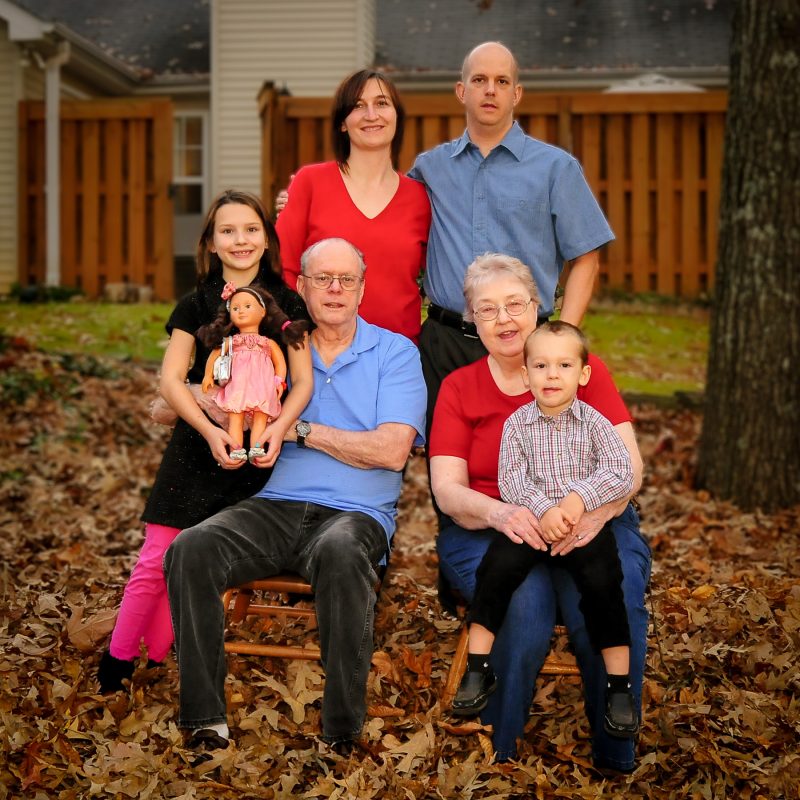As we go through life, we start to see things differently. That really goes without saying, I know, but looking over old photographs makes this so much more literal. I saw today a photograph from 2015 and immediately saw flaws in it. The newest iteration of Lightroom allowed me to fix some of the flaws, but not all of them.

It was the little things.
That gate behind us — why didn’t I think to close it? It would have made the background that much more fluid. (Perhaps I thought I had. Maybe I closed it, but something opened it back up — wind, gravity, a squirrel.)
Why didn’t we move further down the hill so that more leaves would be behind us? It was a simple fix — why didn’t we see it? (Maybe we did — maybe we were as far down as possible. Perhaps just beyond the bottom of the frame the leaves disappear.)
Why didn’t I open the aperture a little more to get a little creamier background? (Perhaps it was as wide open as possible — in 2015, we still didn’t have a great portrait lens. Truth be told, we still don’t, but we’ve got a much better lens than I would have used for this picture.)
It’s no big deal, obviously, but looking back, I see so much wrong with this.
I had a similar thought in Polish Mass today. I hadn’t been to Mass since the last Polish Mass a month ago, and the less frequently I go to Mass, the more foreign it seems. Everyone going onto the stage (I know that’s not what it’s actually called but I can’t remember what it is called, and since it’s an elevated platform upon which the whole ceremony is conducted, it is, for all intents and purposes, a stage) stopped and bowed or genuflected. When I first saw people doing that in Poland, I was curious: why are they doing all that bowing? Once I learned about the idea of the real presence of Jesus in the host (i.e., the idea that somehow the bread ceases to be bread and is actually the body of Jesus), I understood what was going on. It still didn’t make sense because I didn’t believe that was the case, but I understood why they did it.
When I tried being a Catholic, that was one of the doctrines that I thought was just a little off but put it out of my mind. I behaved as if I believed it even though, deep down, I know I never did. It doesn’t make any sense: the official church teaching is that nothing physically changes. You can press a priest on the matter, and he’ll even admit that nothing atomically changes. The logical conclusion: if nothing atomically changes, then nothing changes. Full stop. The bread is made of molecules which are made of atoms which are made of subatomic particles. If nothing in that chain of being changes, then nothing changes. It’s not complicated logic — it’s quite basic in fact.
Yet Catholic apologists will start talking about substance and accident and making Aristotelian moves to suggest that the thing that makes bread bread — the substance — changes but the outward appearance doesn’t. Yet nothing makes bread bread. “Bread” is the name we give molecules of wheat, water, and usually (though not in this case) yeast that have undergone chemical changes through the application of heat. The atoms themselves didn’t change even in the cooking. It’s not complicated logic — it’s quite basic in fact.
Still, as someone attempting to be a believer I watched everyone bowing, I was a little jealous that they seemed actually to believe. I knew I didn’t, though I would not have admitted it to anyone. As my doubts resurfaced several years ago, I eventually realized I didn’t have to pretend I believed anymore that the little tasteless wafer was Jesus himself, and I felt a bit of relief about that.
Today as I watched as the altar servers bowed before going on stage, as the lector bowed before going on stage, as all the parishioners bowed before taking the bit of bread, I found myself back where I started, knowing exactly why they were doing it but still thinking it made little objective sense.
Where is the re-visioning in all that? It’s not that I believed the wafer became anything different; it’s that I saw myself as someone who should believe that but never really did. The re-vision is an understanding that I was almost purposely deluding myself.
0 Comments